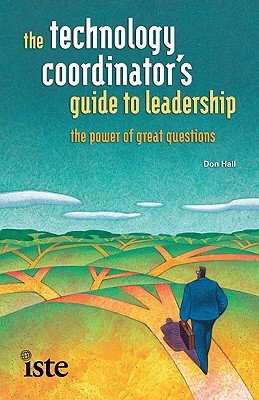 As I continue to grow in my own understanding of the Role of a Technology Director, I increasingly turn to those books and resources (from organizations that I trust) about the topic. This Quarter, I have decided to examine The Technology Director’s Guide to Leadership by Don Hall. This reading is in the middle of several other books including: City of Bones, The Best Students in the World, and Reality is Broken. Hopefully I do not stray too much as I read this book.
As I continue to grow in my own understanding of the Role of a Technology Director, I increasingly turn to those books and resources (from organizations that I trust) about the topic. This Quarter, I have decided to examine The Technology Director’s Guide to Leadership by Don Hall. This reading is in the middle of several other books including: City of Bones, The Best Students in the World, and Reality is Broken. Hopefully I do not stray too much as I read this book.
Don Hall is a Technology Director! He works primarily with large districts and has been a leadership scholar for many years. His book, The Technology Director’s Guide to Leadership is one of the few books the addresses how TD’s interact with the schools they represent. To be honest, I have had this book on my shelf since the ISTE conference in 2013, but it seems to be coming back to me now. Don, and I hope he does not mind that I call him Don, starts his book by identifying several leadership structures: The Sage, The Sensei, and The Oracle. Each of these are amalgamations of classic leadership styles that are given a convenient name so that they are more easily identified.
The first thing that struck me as I was reading the book was this quote:
Individuals are often tapped for technology leadership roles because of their expertise in technology or instruction; however, they are seldom trained in how to be leaders and agents for change at the organizational level.
I could not agree with Don more! What strikes me is that I see two distinctly different leadership styles emerge from Technology Directors that are tapped because of their expertise. Those that come from the Instructional side tend to focus entirely on how the technology will effect teachers, with little regard for the infrastructure and hardware required. On the opposite end, those tapped with expertise from the Technical side often focus their leadership on what they know, the technology. It is my opinion that districts, especially large ones, can no longer afford to be choosing from each group of experts. The newest generation of TD’s will be those teachers and education leaders who emerge with a strong technical background. To be a TD, you need to understand systems and architectures, but you also need to be able to engage with teachers and students on their level (and not be afraid to teach a class or two if necessary).
Now, lets look at those main archetypes again: The Sage, The Sensei, and The Oracle.
Don summarizes the Sage as a leader that “usually sees a project’s goals as more important than maintaining a sense of shared ownership or positive climate. Sages want the right to provide input on nearly all decisions and often have final say on most of them.” In my past, I can see this leadership type in former Principals and Superintendents. Often, when I see this leadership style it is when an organization is in trouble and the Sage is dealing out decisions to try and save it.
The Sensei is characterized as “the facilitator [that] makes things happen by understanding the larger context of the project and the key components necessary to accomplish it effectively.” Don states that the Sensei will often take longer to complete tasks and make decisions while maintaining a high level of expectations for their team. One of my favorite quotes from this book is:
The focus is on building leadership capacity with the expectation that the knowledge and skills will be passed on throughout the rest of the team.
That single quote is the reason I think that most districts should opt into BYOD/BYOC programs, it is a shift from investing in the Device to investing in the Team. Lets build Professional Capital instead of Corporate Capital.
The Oracle is more of a Figurehead and face for the organization. Naturally delegators, they focus on ensuring that stakeholders understand the important messages and products, but can possibly over-delegate loosing touch with the organization.
As one of the exercises, Don asks us to reflect on where we see ourselves on the Leadership Continuum model (from Sage to Sensei to Oracle). When I first started reading this book a couple of years ago, I very easily placed myself in-between Sensei and Oracle. Now as I reflect on my own Leadership, I find myself shifting between all of the Leadership Styles based upon what is most important at the time. In the past six months alone, I have been the Sage, the Sensei, and the Oracle, and I expect that my change between these titles will continue as I grow and develop (and respond) to the team and school that I am a part of.
